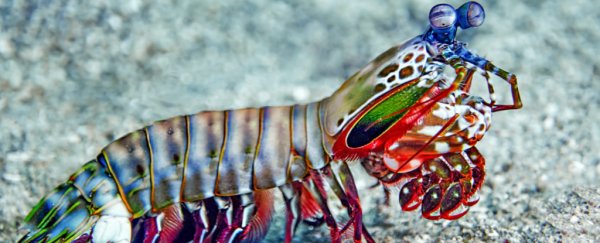The mantis shrimp is quite a fearsome foe. While they're neither shrimp nor mantis, this marine crustacean, measuring about just 10 centimetres (4 inches) long, has incredible eyes that can see cancer, and a club-like hand that can throw the fastest punches in the ocean.
We're talking 23 metres per second, and creating 1,500 newtons of force per punch.
"Think about punching a wall a couple thousand times at those speeds and not breaking your fist," said University of California material scientist David Kisailus.
"That's pretty impressive, and it got us thinking about how this could be."
Upon closer examination, the team found something amazing - discovering that the mantis shrimp has an impact-resistant nanoparticle coating that allows it to punch with reckless abandon, while the coating does the hard work of absorbing and dissipating energy.
In case you'd missed the hype about these little punching machines, some species of mantis shrimp have the ability to use their claw like a spring-loaded hammer.
In a split second, these 'smashers' (yep, that's the technical term) hit down on their hard-bodied prey, such as snails and crabs, to crack tough mollusc shells open like they were eggs.
This is all well-known. Past research has looked at ways the club is so effective, and some studies have even used the mantis shrimp to inspire completely new material.
"These studies revealed that a helicoidal arrangement of mineralised alpha-chitin fibres combined with a herringbone architecture, which results from a mineralisation gradient, can deflect and twist crack propagation," the team explains in a new paper.
"Although the aforementioned studies provide insights to the mechanisms of toughening in the club, the effects of multiple high-strain-rate impacts, similar to those encountered in the native environment of the mantis shrimp, are still not known."
The team used transmission electron and atomic force microscopy to get an exceptionally close-up look at the surface of the peacock mantis shrimps (Odontodactylus scyllarus) club, and found that the coating is made of a dense matrix of a mineral called hydroxyapatite formed into a nanocrystal structure.
When the club is hit against a surface, the hydroxyapatite itself rotates, but the nanocrystal structure fractures and then slowly reforms.
"At relatively low strain rates, the particles deform almost like a marshmallow and recover when the stress is relieved," says Kisailus, while at high strain, "the particles stiffen and fracture at the nanocrystalline interfaces. When you break something, you're opening up new surfaces that dissipate significant amounts of energy."
This mechanism is really quite impressive, beating many engineered materials in stiffness and damping, and it could have some incredible applications in the future.
"It's a rare combination that outperforms most metals and technical ceramics," Kisailus said.
"We can imagine ways to engineer similar particles to add enhanced protective surfaces for use in automobiles, aircraft, football helmets, and body armour."
The research has been published in Nature Materials.
